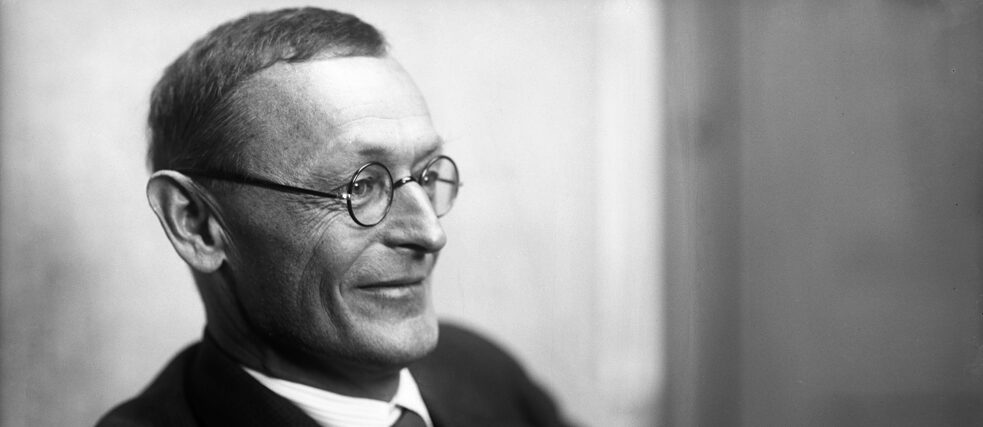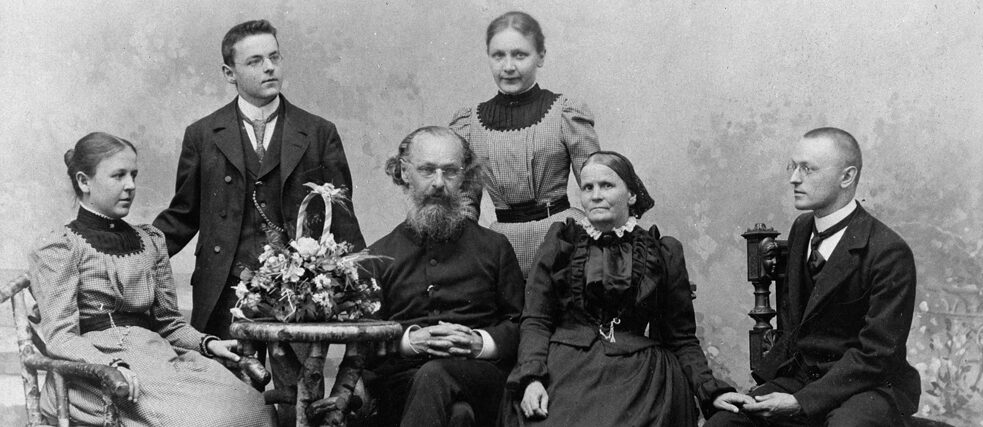Hesse and India
A European novel?

In 1922, Hesse’s Siddhartha was published. It aroused a fascination in India like no other German-language novel and has shaped the image of India ever since. The poet, however, set the plot of the novel in an unnamed past era and never saw India himself.
By Martin Kämpchen
From early childhood, Hermann Hesse was surrounded by an Indian ambience. Growing up in the small Württemberg town of Calw, he listened to the stories of his maternal grandfather, Hermann Gundert, who had long worked in India as a missionary of the Basel Mission. Gundert lived in the southern Indian province of Kerala, learned the Malayalam language and wrote fundamental works on it, especially the Malayalam and English Dictionary (1862) and A Grammar of the Malayalam Language (1868), which are still significant today. Hermann Hesse’s mother was born in Kerala; she and her husband also worked there as missionaries, but they had already returned to Germany when Hermann Hesse was born.
Hesse’s upbringing, however, was not influenced by Indian spirituality, but by strict Protestant pietism. The young Hermann first had to take great pains and effort to liberate himself from the narrowminded piety of his childhood before he was open to other philosophies and religions. Looking back on his early years, he writes:
“Compared to this narrowly confined Christianity [...] the world of Indian religion and poetry was far more enticing. Here, no closeness oppressed me, here it smelled neither of sober grey-layered pulpits nor of pietistic Bible lessons, my imagination had space, I could open myself to the first messages that reached me from the Indian world without resistance, and they have had a lifelong effect.”
Once grown, Hermann Hesse was able to assert himself against his parental home and his pietistic socialisation, and he began to discover Hinduism, Buddhism and Taoism and to accept these religions as spiritual alternatives. He read the sacred scriptures of Hinduism, such as the Bhagavad-Gita and the Upanishads, and he participated in the discovery of the “East” through reviews and newspaper articles. At the turn of the nineteenth to the twentieth century, German Orientalists made the sacred scriptures of Asian religions accessible through authentic translations from the original languages. With his dual groundwork – the Indian ambience of his parental home and the study of the scriptures – Hermann Hesse set off by ship for Asia in 1911. It was his first long journey. He was 34 years old and had travelled extensively in Italy so far, but never beyond European borders. Although the journey went as far as Indonesia and Malaysia, his main destination was India and there Kerala, the area where his grandfather and parents had worked as missionaries for decades.
 The family of Johannes and Marie Hesse-Gundert, from left to right, daughter Adele, son Hans, father Johannes, daughter Marulla, mother Marie, son Hermann, taken in Calw in 1899. | © KEYSTONE/MARTIN-HESSE-ERBEN/Anonymous
The family of Johannes and Marie Hesse-Gundert, from left to right, daughter Adele, son Hans, father Johannes, daughter Marulla, mother Marie, son Hermann, taken in Calw in 1899. | © KEYSTONE/MARTIN-HESSE-ERBEN/Anonymous
Shortly after the turn of the century, other well-known German-language writers travelled to India, including Waldemar Bonsels (1904), Max Dautendey (1905-06 and later), Rudolf Kassner (1908) and Stefan Zweig (1908-09), the philosopher Hermann Keyserling (1911-12) along with writer René Schickele (1913). After the opening of the Suez Canal in 1869 significantly shortened the eastern sea route and travel agencies began offering voyages to India, writers and artists journeyed to India to compare reality with the dreams and fantasies of romantics who had never seen India with their own eyes. Many wrote about India, some dismissively like Stefan Zweig, others cynically like Waldemar Bonsels, still others with a great desire for observation and an urge for understanding like Max Dauthendey and, indeed, Hermann Hesse.
The journey ended in disappointment for Hermann Hesse due to unfortunate circumstances. On the voyage, Hesse suffered from relentless seasickness and was only able to complete the journey with constant doses of morphine. For this reason, he did not stop in South India on his return journey but instead travelled straight from Sri Lanka to Italy and from there to his homeland.
He spent two weeks in Sri Lanka and explored it with amazing openness, curiosity and energy. But his impressions, recorded in his diary, were by and large negative. Disappointed, he could not discover the “eternal India” he had in mind through his reading of the sacred scriptures; not the pure, noble piety shaped by Buddhism. This disappointment must have been the reason Hesse did not put anything significant to paper about his trip to Asia apart from a few essays in newspapers and magazines. He, who had the most intense connection to India among the writers of his time, returned virtually empty-handed. He had, however, a higher aim than merely documenting a journey. He expressed this in his essay “Remembrance of India” (1917) as follows:
“This minor, ancient truism, that there is one humanity across the borders of peoples and continents, was for me the last and greatest experience of that journey [...] Only from here again, from the feeling of brotherhood and inner equality, does the foreign, the different, the colourfulness of the countries and people acquire their innermost and highest charm and magic.”
Today we would speak of multiculturism and diversity, the value of which became clear to the poet on this journey. It took a whole decade for his India experience to be reflected in a large, coherent work, his “Indian poem,” the novel Siddhartha. Personal disasters and illness initially prevented him from writing it down. The First World War, which Hermann Hesse, unlike many contemporaries, resolutely opposed, rolled over Europe. Hesse observed it with great concern from his Swiss refuge and campaigned for the war’s victims. His income dropped threateningly.
Around 1919, we then read in letters about Hesse’s plan for an Indian poem. Why did he cling to India, what was the deepest motivation for Siddhartha? The poet explains: “I have been convinced for many years that the European spirit is in decline and needs to return to its Asian sources.” Basically, Hermann Hesse is a missionary of the upright spiritual way of life. He wrote Siddhartha in the service of this inner mission. His monk Siddhartha is an ideally typical representative of the Indian way – the same way that Hermann Hesse saw before him through his studies of Indian scriptures. Only a short time after the book appeared in 1922, he happened to meet an Indian scholar, Kalidas Nag, at a conference in Lugano, to whom he retold the life story of Siddhartha. Hesse heard the Indian’s praise with great satisfaction.
The novel traces the life of the monk Siddhartha, who passes through several phases in his search for divine truth. He begins as a seeker or novice, then turns away from monasticism and becomes the lover of Kamala and father of a son, as well as a successful businessman. Finally, he gives up this life in the “world” with all its joys and sufferings and becomes a hermit on the banks of a river. Hesse depicts not so much the life of Indian monks as that of modern Western man, who restlessly follows varying drives and longings. Hesse himself admits that Siddhartha is a “European” book.
Siddhartha was read intensively in the era after the Second World War until the 1960s and 1970s, when German youth in search of spiritual orientation discovered Hermann Hesse and, among other ideological books, made Siddhartha the guideline for their actions. Curiously, it was the hippie generation that carried the book with them like a bible, although they were unwilling to tame their lifestyles with Siddhartha’s discipline and willingness to sacrifice. Siddhartha became perhaps the most important literary book about India for Germans in the twentieth century. And although Hermann Hesse had no intention of depicting it in a realistic, contemporary way, no other book had such a major influence on their image of India.
Comments
Comment